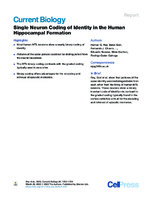- DSpace Principal
- →
- Hospital El Cruce
- →
- Publicaciones
- →
- Artículos
- →
- Ver ítem
JavaScript is disabled for your browser. Some features of this site may not work without it.
Mostrar el registro sencillo del ítem
| dc.contributor.author | Rey, Hernán | |
| dc.contributor.author | Gori, Belén | |
| dc.contributor.author | Chaure, Fernando | |
| dc.contributor.author | Collavini, Santiago | |
| dc.contributor.author | Blenkmann, Alejandro | |
| dc.contributor.author | Seoane, Pablo | |
| dc.contributor.author | Seoane, Eduardo | |
| dc.contributor.author | Kochen, Silvia | |
| dc.contributor.author | Quian Quiroga, Rodrigo | |
| dc.date.accessioned | 2021-03-01T04:35:30Z | |
| dc.date.available | 2021-03-01T04:35:30Z | |
| dc.date.issued | 2020-03-05 | |
| dc.identifier.uri | https://doi.org/10.1016/j.cub.2020.01.035 | |
| dc.identifier.uri | https://www.ncbi.nlm.nih.gov/pmc/articles/PMC7103760/ | |
| dc.identifier.uri | http://repositorio.hospitalelcruce.org/xmlui/handle/123456789/1087 | |
| dc.description.abstract | Experimental findings show the ubiquitous presence of graded responses and tuning curves in the neocortex, particularly in visual areas [1-15]. Among these, inferotemporal-cortex (IT) neurons respond to complex visual stimuli, but differences in the neurons' responses can be used to distinguish the stimuli eliciting the responses [8, 9, 16-18]. The IT projects directly to the medial temporal lobe (MTL) [19], where neurons respond selectively to different pictures of specific persons and even to their written and spoken names [20-22]. However, it is not clear whether this is done through a graded coding, as in the neocortex, or a truly invariant code, in which the response-eliciting stimuli cannot be distinguished from each other. To address this issue, we recorded single neurons during the repeated presentation of different stimuli (pictures and written and spoken names) corresponding to the same persons. Using statistical tests and a decoding approach, we found that only in a minority of cases can the different pictures of a given person be distinguished from the neurons' responses and that in a larger proportion of cases, the responses to the pictures were different to the ones to the written and spoken names. We argue that MTL neurons tend to lack a representation of sensory features (particularly within a sensory modality), which can be advantageous for the memory function attributed to this area [23-25], and that a full representation of memories is given by a combination of mostly invariant coding in the MTL with a representation of sensory features in the neocortex. | es_AR |
| dc.language.iso | en | es_AR |
| dc.relation.ispartofseries | Curr Biol.;2020 Mar 23;30(6):1152-1159.e3 | |
| dc.subject | Hipocampo | es_AR |
| dc.title | Single Neuron Coding of Identity in the Human Hippocampal Formation | es_AR |
| dc.type | Article | es_AR |
Ficheros en el ítem
Este ítem aparece en la(s) siguiente(s) colección(ones)
-
Artículos
Articles

